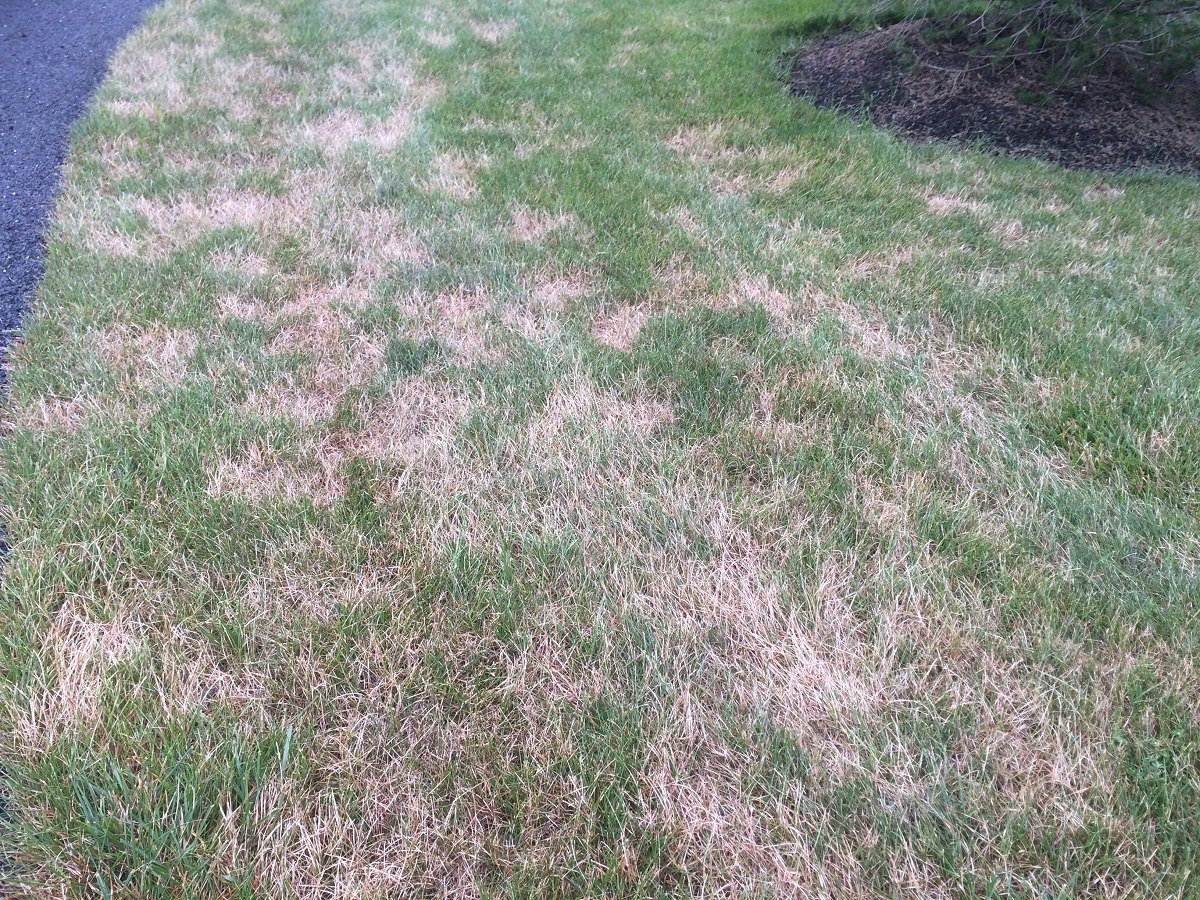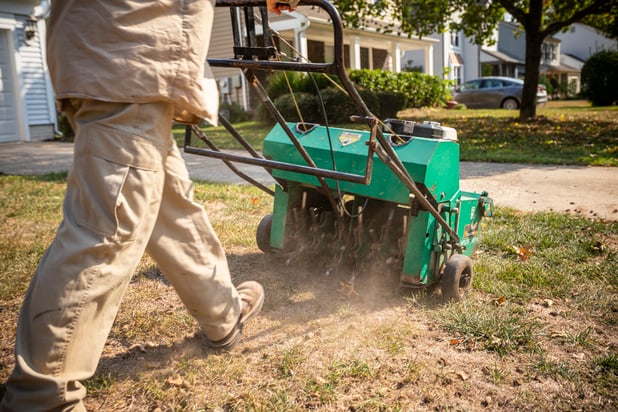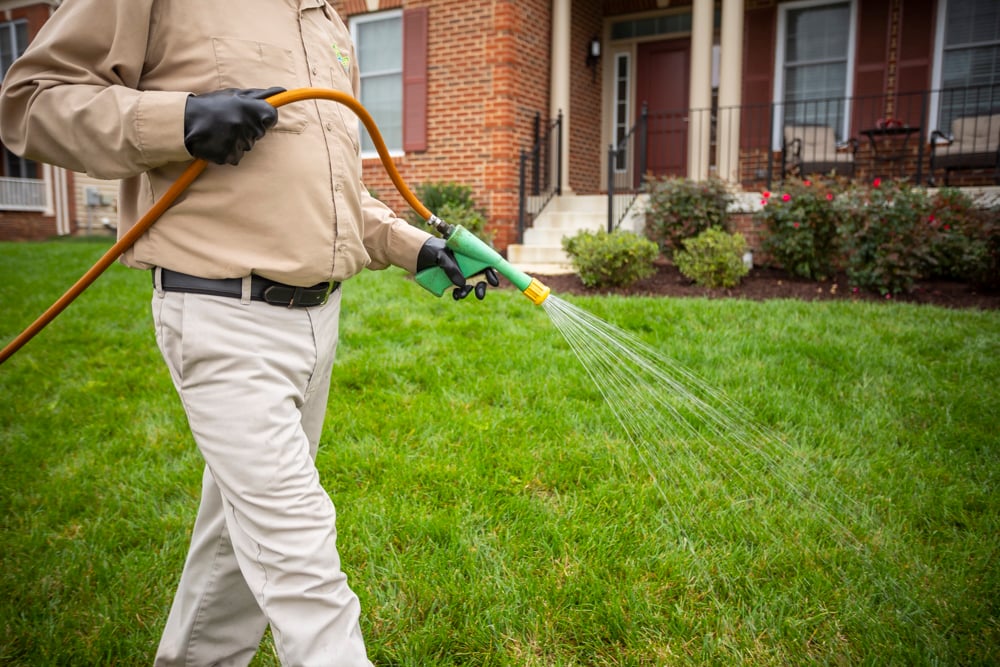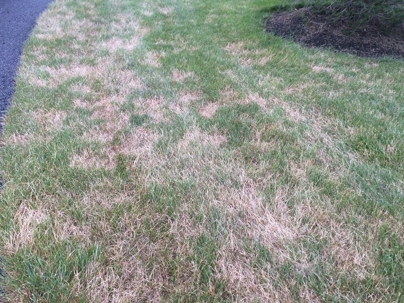5 Critical Turf Disease Facts and How Lawn Fungus Control Works
Weeds are the in-your-face criminals of the movie about your lawn with their bold intrusion into your space and blatant disregard for your desire to have a gorgeous green lawn. They barge in kind of like Transformers’ evil Megatron without a care for the destruction they’re leaving in their wake.
Turf diseases, on the other hand, are their stealth-like sidekicks. While weeds are making all the noise and distraction over here, diseases are more like Catwoman, sneaking in when and where you least expect them. And before you know it, you have a full lawn fungus infestation.
We get it, just when you understand one lawn invader, you have to learn about another. Turf diseases can be hard to understand.
Here are some of the most critical turf disease contributors and how lawn fungus control works.
How Lawn Fungus Works in Central and Southern Maryland
You can work hard all year to make sure your lawn is perfect for the summer, but then you notice something isn’t right. There are patchy sections that are appearing within your green lawn.
 That’s usually the biggest sign of a lawn fungus infestation: circular patchiness. Other common symptoms are lawn discoloration, brown spots, dead areas and spots on the actual grass blades.
That’s usually the biggest sign of a lawn fungus infestation: circular patchiness. Other common symptoms are lawn discoloration, brown spots, dead areas and spots on the actual grass blades.
Turf diseases can be challenging to identify because, unlike lawn weeds, they are primarily microscopic in nature. So what you see are the infestation results.
Use This Tool to Compare Your Local Lawn Care Companies
When your lawn is in good health, turf disease can come through and look pretty bad for the season but then go away when conditions that spike it go away, leaving minimal damage. However, lawn fungus that is encouraged with the right triggers on a lawn that isn’t properly maintained can leave dead spots in its wake.
To understand lawn fungus, you might first understand what conditions cause it to thrive. There are 5 critical components that lead to turf disease.
1. High Nighttime Temperatures
You know lawn fungus can become a problem when you start to see that nighttime temperatures remain high overnight.
In Central and Southern Maryland, this usually happens in mid-May, but can happen in late April if spring is warm. What this means is that on an 85-degree day, you'll notice the nighttime temperatures only go down to the 70s or maybe even high 60s. Usually temperatures in the low 60s are cool enough to keep disease at bay.
High nighttime temperatures are a problem because they keep the atmosphere around a lawn warm and, without airflow, this contributes to turf disease development.
2. Humidity
High temperatures are usually accompanied by high humidity, another factor that can encourage turf disease.
Humidity keeps the lawn damp, and lawn fungus thrives in that dark, warm, wet environment.
3. Lack of Air Flow
If your yard is surrounded by woods or a privacy fence that breaks the wind, you could have a higher chance of lawn fungus problems.
Good air circulation dramatically decreases lawn fungus problems. Properties in parts of Maryland that are on the water have been able to limit turf disease issues even at times of high nighttime temperatures and high humidity because they have great air moving through their properties, removing the excess moisture.
4. Overwatering
Too much water, especially water applied to a lawn in the evening or at night, can amplify lawn fungus problems.
Rain isn’t the biggest factor here, though it can play a part. But if you water your lawn improperly and too frequently or schedule your lawn irrigation system to overwater or water at the wrong times of day, this can contribute to lawn fungus growth.
Proper lawn watering means applying 1 to 1.5 inches of water per week to your lawn divided into no more than two or three waterings. This is best done in the mornings.
You don’t want to water every day and you don’t want to water at night because combined with high temperatures and humidity, this adds to the conditions that can increase turf disease in your yard.
5. Fertility, Mowing and Aeration
Other contributing factors that help contribute to turf disease include improper fertilization, mowing too short and skipping annual aeration.
Mowing below that 3-inch mark will stress your turfgrass. Likewise, mowing too high will stifle air flow and cause even more turf disease.
Routinely fertilizing in smaller amounts throughout the year provides adequate nutrition for your grass and reduces fluctuating fertility levels that promotes the Similarly, a lawn spread of lawn fungus.
 Aeration can also play a role in keeping the lawn healthy because, done annually, it helps to keep the grass plant vigorous and thriving. It also breaks up thick turf and thatch build-up which helps to prevent turf disease. Why? Because turf that is too thick and stifled can lack air flow.
Aeration can also play a role in keeping the lawn healthy because, done annually, it helps to keep the grass plant vigorous and thriving. It also breaks up thick turf and thatch build-up which helps to prevent turf disease. Why? Because turf that is too thick and stifled can lack air flow.
How Lawn Fungus Control Works in Maryland
Now that you know what conditions turf disease prefers, let’s talk about what you can do for lawn fungus control.
The three most common turf diseases in Central and Southern Maryland are brown patch, dollar spot and pythium blight. They have similar symptoms with some slight differences the trained eye can spot. But all three can be controlled with similar strategies.
Unfortunately, 80 percent of all lawns in Central and Southern Maryland will get turf disease in the summer. This is particularly true in Southern Maryland. The conditions listed above just tend to line up perfectly as a breeding ground for lawn fungus.
What this means is that even the best lawns will look run down and pretty shabby during June, July and August.
But there are some things you can do to keep your lawn looking its best.
1. Maximize Proper Turf Care
To keep turf disease at bay, target that list above. Put these action items on your to-do list:
- Don’t mow your lawn below 3 inches at a time or remove more than ⅓ of the total height of the grass blade in one mowing.
- Don’t water at night or every day.
- Don’t water more than 1.5 inches a week.
- Don’t ignore fertilization or pile on extra fertilization. More is never better.
- Don’t skip annual aeration.
- Don’t ignore weather conditions that could lead to lawn fungus growth.
Keeping your lawn health at its best will help it survive the peak of turf disease growth.
2. Turf Disease Control
Do you have a yard that is fenced in or backs up to woods? Does the airflow on your property seem stagnant during the summer? Do you regularly notice circular, discolored patches in your lawn each year?
Then your lawn is likely more susceptible to turf disease, and you might want to consider a lawn fungus control program.
 A lawn fungus control program is typically an add-on to your current lawn care program and is made up of two to three fungicide treatments. Each treatment for a 5,000-square-foot lawn can cost roughly $150.
A lawn fungus control program is typically an add-on to your current lawn care program and is made up of two to three fungicide treatments. Each treatment for a 5,000-square-foot lawn can cost roughly $150.
Turf diseases, just like lawn weeds, are best controlled preventively. So if we see the conditions coming and you know your lawn is at risk, then it’s a good program to ask about early in the season as you see temperatures rising.
If you have a newer lawn or have recently overseeded or seeded some bare spots, turf disease can really ravage the lawn because it is too young to fight. In this case, you may also want to explore lawn fungus control.
You Have Options When Turf Diseases Crop Up in Your Central & Southern Maryland Lawn
When lawn fungus erupts, it can make your lawn look shabby and tired and very discolored and splotchy during those prime summer months.
Turf diseases may be stealth-like in their ability to appear out of nowhere. But the knowledge you can obtain to better understand them and their growing tendencies gives you the power to fight back and protect your beloved lawn from these villains.
Choosing Natural Green for a lawn fungus control program helps you put a true superhero on your team to help you protect your lawn from the spread of turf disease.
Are turf diseases keeping you from having a lawn you can be proud of? We’d love to learn more. Get started today with a free quote. Together, we’ll prepare a customized plan that leads you to the best choice for you and your lawn.
Weeds are the in-your-face criminals of the movie about your lawn with their bold intrusion into your space and blatant disregard for your desire to have a gorgeous green lawn. They barge in kind of like Transformers’ evil Megatron without a care for the destruction they’re leaving in their wake.
Turf diseases, on the other hand, are their stealth-like sidekicks. While weeds are making all the noise and distraction over here, diseases are more like Catwoman, sneaking in when and where you least expect them. And before you know it, you have a full lawn fungus infestation.
We get it, just when you understand one lawn invader, you have to learn about another. Turf diseases can be hard to understand.
Here are some of the most critical turf disease contributors and how lawn fungus control works.
How Lawn Fungus Works in Central and Southern Maryland
You can work hard all year to make sure your lawn is perfect for the summer, but then you notice something isn’t right. There are patchy sections that are appearing within your green lawn.
 That’s usually the biggest sign of a lawn fungus infestation: circular patchiness. Other common symptoms are lawn discoloration, brown spots, dead areas and spots on the actual grass blades.
That’s usually the biggest sign of a lawn fungus infestation: circular patchiness. Other common symptoms are lawn discoloration, brown spots, dead areas and spots on the actual grass blades.
Turf diseases can be challenging to identify because, unlike lawn weeds, they are primarily microscopic in nature. So what you see are the infestation results.
Use This Tool to Compare Your Local Lawn Care Companies
When your lawn is in good health, turf disease can come through and look pretty bad for the season but then go away when conditions that spike it go away, leaving minimal damage. However, lawn fungus that is encouraged with the right triggers on a lawn that isn’t properly maintained can leave dead spots in its wake.
To understand lawn fungus, you might first understand what conditions cause it to thrive. There are 5 critical components that lead to turf disease.
1. High Nighttime Temperatures
You know lawn fungus can become a problem when you start to see that nighttime temperatures remain high overnight.
In Central and Southern Maryland, this usually happens in mid-May, but can happen in late April if spring is warm. What this means is that on an 85-degree day, you'll notice the nighttime temperatures only go down to the 70s or maybe even high 60s. Usually temperatures in the low 60s are cool enough to keep disease at bay.
High nighttime temperatures are a problem because they keep the atmosphere around a lawn warm and, without airflow, this contributes to turf disease development.
2. Humidity
High temperatures are usually accompanied by high humidity, another factor that can encourage turf disease.
Humidity keeps the lawn damp, and lawn fungus thrives in that dark, warm, wet environment.
3. Lack of Air Flow
If your yard is surrounded by woods or a privacy fence that breaks the wind, you could have a higher chance of lawn fungus problems.
Good air circulation dramatically decreases lawn fungus problems. Properties in parts of Maryland that are on the water have been able to limit turf disease issues even at times of high nighttime temperatures and high humidity because they have great air moving through their properties, removing the excess moisture.
4. Overwatering
Too much water, especially water applied to a lawn in the evening or at night, can amplify lawn fungus problems.
Rain isn’t the biggest factor here, though it can play a part. But if you water your lawn improperly and too frequently or schedule your lawn irrigation system to overwater or water at the wrong times of day, this can contribute to lawn fungus growth.
Proper lawn watering means applying 1 to 1.5 inches of water per week to your lawn divided into no more than two or three waterings. This is best done in the mornings.
You don’t want to water every day and you don’t want to water at night because combined with high temperatures and humidity, this adds to the conditions that can increase turf disease in your yard.
5. Fertility, Mowing and Aeration
Other contributing factors that help contribute to turf disease include improper fertilization, mowing too short and skipping annual aeration.
Mowing below that 3-inch mark will stress your turfgrass. Likewise, mowing too high will stifle air flow and cause even more turf disease.
Routinely fertilizing in smaller amounts throughout the year provides adequate nutrition for your grass and reduces fluctuating fertility levels that promotes the Similarly, a lawn spread of lawn fungus.
 Aeration can also play a role in keeping the lawn healthy because, done annually, it helps to keep the grass plant vigorous and thriving. It also breaks up thick turf and thatch build-up which helps to prevent turf disease. Why? Because turf that is too thick and stifled can lack air flow.
Aeration can also play a role in keeping the lawn healthy because, done annually, it helps to keep the grass plant vigorous and thriving. It also breaks up thick turf and thatch build-up which helps to prevent turf disease. Why? Because turf that is too thick and stifled can lack air flow.
How Lawn Fungus Control Works in Maryland
Now that you know what conditions turf disease prefers, let’s talk about what you can do for lawn fungus control.
The three most common turf diseases in Central and Southern Maryland are brown patch, dollar spot and pythium blight. They have similar symptoms with some slight differences the trained eye can spot. But all three can be controlled with similar strategies.
Unfortunately, 80 percent of all lawns in Central and Southern Maryland will get turf disease in the summer. This is particularly true in Southern Maryland. The conditions listed above just tend to line up perfectly as a breeding ground for lawn fungus.
What this means is that even the best lawns will look run down and pretty shabby during June, July and August.
But there are some things you can do to keep your lawn looking its best.
1. Maximize Proper Turf Care
To keep turf disease at bay, target that list above. Put these action items on your to-do list:
- Don’t mow your lawn below 3 inches at a time or remove more than ⅓ of the total height of the grass blade in one mowing.
- Don’t water at night or every day.
- Don’t water more than 1.5 inches a week.
- Don’t ignore fertilization or pile on extra fertilization. More is never better.
- Don’t skip annual aeration.
- Don’t ignore weather conditions that could lead to lawn fungus growth.
Keeping your lawn health at its best will help it survive the peak of turf disease growth.
2. Turf Disease Control
Do you have a yard that is fenced in or backs up to woods? Does the airflow on your property seem stagnant during the summer? Do you regularly notice circular, discolored patches in your lawn each year?
Then your lawn is likely more susceptible to turf disease, and you might want to consider a lawn fungus control program.
 A lawn fungus control program is typically an add-on to your current lawn care program and is made up of two to three fungicide treatments. Each treatment for a 5,000-square-foot lawn can cost roughly $150.
A lawn fungus control program is typically an add-on to your current lawn care program and is made up of two to three fungicide treatments. Each treatment for a 5,000-square-foot lawn can cost roughly $150.
Turf diseases, just like lawn weeds, are best controlled preventively. So if we see the conditions coming and you know your lawn is at risk, then it’s a good program to ask about early in the season as you see temperatures rising.
If you have a newer lawn or have recently overseeded or seeded some bare spots, turf disease can really ravage the lawn because it is too young to fight. In this case, you may also want to explore lawn fungus control.
You Have Options When Turf Diseases Crop Up in Your Central & Southern Maryland Lawn
When lawn fungus erupts, it can make your lawn look shabby and tired and very discolored and splotchy during those prime summer months.
Turf diseases may be stealth-like in their ability to appear out of nowhere. But the knowledge you can obtain to better understand them and their growing tendencies gives you the power to fight back and protect your beloved lawn from these villains.
Choosing Natural Green for a lawn fungus control program helps you put a true superhero on your team to help you protect your lawn from the spread of turf disease.
Are turf diseases keeping you from having a lawn you can be proud of? We’d love to learn more. Get started today with a free quote. Together, we’ll prepare a customized plan that leads you to the best choice for you and your lawn.
Share This
Topics: Lawn Care


